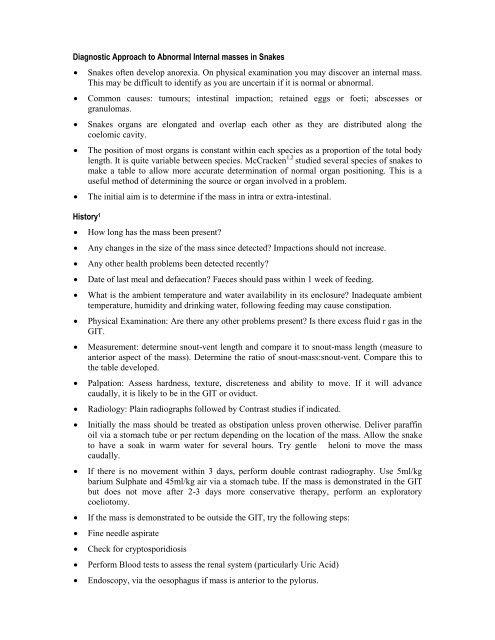Handling and Nursing Reptiles - Australian Veterinary Association
Handling and Nursing Reptiles - Australian Veterinary Association
Handling and Nursing Reptiles - Australian Veterinary Association
You also want an ePaper? Increase the reach of your titles
YUMPU automatically turns print PDFs into web optimized ePapers that Google loves.
Diagnostic Approach to Abnormal Internal masses in Snakes<br />
Snakes often develop anorexia. On physical examination you may discover an internal mass.<br />
This may be difficult to identify as you are uncertain if it is normal or abnormal.<br />
Common causes: tumours; intestinal impaction; retained eggs or foeti; abscesses or<br />
granulomas.<br />
Snakes organs are elongated <strong>and</strong> overlap each other as they are distributed along the<br />
coelomic cavity.<br />
The position of most organs is constant within each species as a proportion of the total body<br />
length. It is quite variable between species. McCracken 1,2 studied several species of snakes to<br />
make a table to allow more accurate determination of normal organ positioning. This is a<br />
useful method of determining the source or organ involved in a problem.<br />
The initial aim is to determine if the mass in intra or extra-intestinal.<br />
History 1<br />
How long has the mass been present?<br />
Any changes in the size of the mass since detected? Impactions should not increase.<br />
Any other health problems been detected recently?<br />
Date of last meal <strong>and</strong> defaecation? Faeces should pass within 1 week of feeding.<br />
What is the ambient temperature <strong>and</strong> water availability in its enclosure? Inadequate ambient<br />
temperature, humidity <strong>and</strong> drinking water, following feeding may cause constipation.<br />
Physical Examination: Are there any other problems present? Is there excess fluid r gas in the<br />
GIT.<br />
Measurement: determine snout-vent length <strong>and</strong> compare it to snout-mass length (measure to<br />
anterior aspect of the mass). Determine the ratio of snout-mass:snout-vent. Compare this to<br />
the table developed.<br />
Palpation: Assess hardness, texture, discreteness <strong>and</strong> ability to move. If it will advance<br />
caudally, it is likely to be in the GIT or oviduct.<br />
Radiology: Plain radiographs followed by Contrast studies if indicated.<br />
Initially the mass should be treated as obstipation unless proven otherwise. Deliver paraffin<br />
oil via a stomach tube or per rectum depending on the location of the mass. Allow the snake<br />
to have a soak in warm water for several hours. Try gentle heloni to move the mass<br />
caudally.<br />
If there is no movement within 3 days, perform double contrast radiography. Use 5ml/kg<br />
barium Sulphate <strong>and</strong> 45ml/kg air via a stomach tube. If the mass is demonstrated in the GIT<br />
but does not move after 2-3 days more conservative therapy, perform an exploratory<br />
coeliotomy.<br />
If the mass is demonstrated to be outside the GIT, try the following steps:<br />
Fine needle aspirate<br />
Check for cryptosporidiosis<br />
Perform Blood tests to assess the renal system (particularly Uric Acid)<br />
Endoscopy, via the oesophagus if mass is anterior to the pylorus.

















